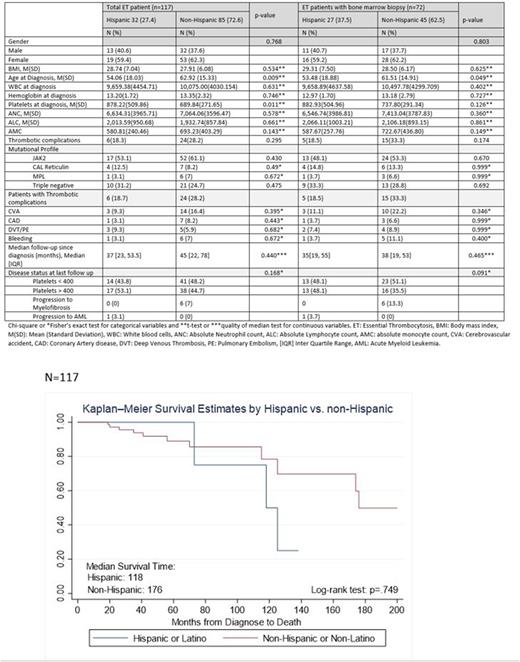Abstract
Background: Essential thrombocytosis (ET) is one of the BCR/ABL negative myeloproliferative neoplasm (MPN) characterized by clonal platelet production leading to thrombocytosis, symptom burden, a tendency for thrombosis, and hemorrhage.
The 2016 revision of WHO diagnostic criteria for myeloid and lymphoid neoplasm emphasizes the need for bone marrow (BM) biopsy to characterize MPN subgroups leading to the improved diagnostic accuracy of MPNs in general and ET in particular. The prevalence of ET compared to other BCR/ABL negative MPN is relatively high, up to 24 per 100,000.
There are racial and ethnic differences in the incidence of ET. Hispanics have a lower incidence rate than Non-Hispanic Whites, with an Incidence rate ratio of 0.66. The impact of the 2016 WHO revision on population incidence and prevalence of ET has not been well characterized. Also, data on the Hispanic subpopulation living in the United States is sparse in the literature.
Central Valley of California has a significant Hispanic population, with more than 50% in some communities. This study compares clinical characteristics, molecular profiles, and outcomes of Hispanic vs. Non-Hispanics ET patients treated in Community Medical Centers (CMC), a major academic center in the central valley of California.
Methods: Retrospective review of Electronic Medical Records (Epic) to identify ET patients treated between January 2016 and January 2021. 769 subjects were initially identified using the slicer dicer tool. 117 patients met the inclusion criteria for further evaluation. Subjects diagnosed with ET before 2016 were included in the study if they followed up within the study period. Patients were grouped into Hispanic and non-Hispanic subgroups. A Redcap data survey was used to collect clinical, pathologic, molecular, and treatment outcomes. Rates and proportions were used to tabulate data. Categorical variables were evaluated with Chi-square and Fisher's exact test.
Kaplan Meier Curve and log-rank test were used to examine the survival rate for Hispanics vs. non-Hispanic. The CMC institutional review board approved the study
Results:
Of the 117 patients with essential thrombocytosis, 72(61.5%) had a complete evaluation, including BM biopsy.
The mean age at diagnosis for the whole group is 60.5 yrs (SD 16.5), with females 72 (61.5%) and Caucasians 72 (61.5%) predominance. African Americans accounted for 2.6%, consistent with the local demographics. Hispanic/Latino ethnicity accounted for 32(27.4%). The median platelet and absolute lymphocyte count (ALC) at diagnosis were 651 (IQR 508-888) and 1900(IQR 1295-2450), respectively. The mutational distribution for the population was JAK2 69 (58.9%), CALR 11(9.4%), MPL 7(5.9%), and triple-negative 31(26.4%), consistent with the literature.
Complications in the population include; thrombosis, mainly stroke 30 (25.6%), and bleeding 7(5.9%) occurred during the study period. Hydroxyurea 71(60.6%) was the most commonly utilized treatment agent, followed by Anagralide 10(8.5%). Most patients are on aspirin 88(75.2%) as thromboprophylaxis.
A total of 7 patients progressed in the cohort, 6 to Myelofibrosis and 1 to AML. 102 (87.1%) patients are still alive at the data cut-off.
When comparing Hispanics vs. non-Hispanics in the population, there is no significant difference in gender, BMI at diagnosis, ALC, complication rate (thrombosis and or bleeding), disease progression, and survival (Table 1)
Hispanics, however, presented at a younger age (54 vs. 62.9 p-value 0.009) yrs and a higher platelet count at diagnosis (878 vs. 878 p-value 0.011). The younger age at diagnosis remains significant in the cohort of ET patients with complete evaluation, including BM biopsy.
22 triple-negative patients (9 Hispanic vs. 13 Non-Hispanic) who underwent next-generation sequencing revealed an abnormal mutation in 4 Hispanic (TP53, CSF3R, BCOR/BRCA1/RASGEF1A, ASXL1/IKZF1) and 3 Non-Hispanic (1 KMT2C, 2 IKZF1).
The non-Hispanic subgroup has numerically higher but statistically insignificant thrombotic complications 24(28.2%) vs. 6(18.7%).
Conclusion: Non-Hispanic white females represent the majority of the ET patient population in our study. Hispanic patients are diagnosed at a younger age with a higher platelet count. The younger age may explain the numerically lower incidence of thrombotic complications in the Hispanics, which needs further evaluation with a larger cohort.
Disclosures
Bukari:Seattle Genetics, Inc: Honoraria, Membership on an entity's Board of Directors or advisory committees; EUSA Pharma: Honoraria, Membership on an entity's Board of Directors or advisory committees; NeoGenomics Laboratories, Inc: Research Funding; SANOFI: Honoraria; Pfizer: Honoraria, Membership on an entity's Board of Directors or advisory committees; HCG-MorphoSys: Honoraria, Membership on an entity's Board of Directors or advisory committees.
Author notes
Asterisk with author names denotes non-ASH members.


This feature is available to Subscribers Only
Sign In or Create an Account Close Modal